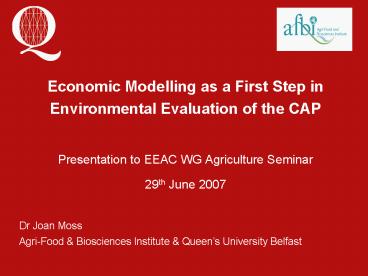Economic Modelling as a First Step in - PowerPoint PPT Presentation
1 / 24
Title:
Economic Modelling as a First Step in
Description:
Dairy (liquid milk, butter, cheese, SMP & WMP) Poultry. Pigs ... Autumn calving - 8,000 l/cow; 2.0 t ration of concentrates grass silage/cow ... – PowerPoint PPT presentation
Number of Views:84
Avg rating:3.0/5.0
Title: Economic Modelling as a First Step in
1
- Economic Modelling as a First Step in
- Environmental Evaluation of the CAP
- Presentation to EEAC WG Agriculture Seminar
- 29th June 2007
Dr Joan Moss Agri-Food Biosciences Institute
Queens University Belfast
2
Economists model at the sectoral (macro) and
individual farm (micro) levels How can
econometric models of agricultural sectors and
programming models of representative farms
provide useful information for the environmental
evaluation of the Common Agricultural Policy?
3
Contents
- Sectoral economic modelling in the FAPRI-UK
project
- Examples of CAP Reform policy scenarios analysed
and price and production results generated
- Representative bio-economic Farm Models and
example of farm-level results
- Results from economic modelling feeding through
to environmental evaluation
4
Sectoral Economic Modelling Methodology
FAPRI-UK Projects four country models
- Four sets of econometrically estimated demand and
supply models for the main agricultural sectors
of England, Wales, Scotland and Northern Ireland
- These models comprise the UK component of the
GOLD (EU) model operated by FAPRI Missouri and
are solved simultaneously with EU models
- The GOLD model is linked to the FAPRI Global
modelling system
5
Sectoral Economic Modelling Methodology
FAPRI-UK models structure and function
- Models capture linkages between main agricultural
sectors in England, Wales, Scotland N Ireland
- UK agricultural sectors linked to European and
Global markets
- Models simulate all the key physical and
financial relationships
- Variables which capture key policy measures also
included
6
Sectoral Economic Modelling Methodology
FAPRI Global Model
FAPRI EU Gold Model
UK Models (E, W, S, NI)
7
Sectoral Economic Modelling Methodology
- Commodity Coverage
- Cereals (wheat, barley, oats rapeseed)
- Beef
- Sheep
- Dairy (liquid milk, butter, cheese, SMP WMP)
- Poultry
- Pigs
8
Sectoral Economic Modelling Methodology
- Models are updated on an annual basis
- New (latest) data are added
- Equations are re-estimated
- Model structure updated/altered to account for
new policy market changes - Validation and calibration procedures critical
9
Sectoral Economic Modelling Methodology
Approach to Policy Analysis
- Models generate 10 year
- Baseline projection - assuming current policies
remain unchanged - Policy scenario projections - set of policy
assumptions pertaining over 10 years - Comparison made between each Scenario and
Baseline projections
10
Sectoral Economic Modelling Methodology
Policy Scenarios project changes in
- agricultural prices
- agricultural production levels
- stock numbers, acreage and yields
- agricultural incomes
11
Sectoral Economic Modelling Methodology
It is important to note that the models generate
projections not forecasts
12
Examples of FAPRI-UK CAP Scenarios Analysed
- Impact of Fischler CAP Reform on the UK beef
sector compared with continuation of Agenda 2000
policy regime
2. Abolition of EU milk quota with existing
International Trade Rules full Export Subsidy
elimination
13
1. Analysis of the impact of the Fischler CAP
Reforms on the UK beef sector
14
Impact of Fischler Reforms
UK Beef Cows
Fischler Reform 17 lower than Agenda 2000 in
2014
15
- Projection of GHG emissions from agriculture
- Example of how results from sectoral modelling
can be used to assess an environmental impact - Projections of CAP Reforms impact on production
in livestock sectors can be used to to quantify
GHG emissions. - Estimated livestock numbers combined with
fertilizer usage can be applied to an Emissions
model (FAPRI-Ireland) to estimate Mt CO2
equivalents
16
Emissions model
Animal numbers
Animal numbers
Emission levels (Mt CO2 equivalents)
Emission factors
Fertilizer application
Fertilizer application
IPCC guidelines
17
2. Analysis of impact of abolition of EU milk
quotas
18
Abolition of EU Milk Quotas
UK Milk Price
Scenario 11 lower than Baseline in 2016
19
Identification of Optimal Production Systems
Price projections from econometric sectoral
models of CAP reforms can be applied to
Bio-Economic Representative Farm Models to
identify optimal (profit maximising) production
systems at farm level
20
Bio-Economic Representative Farm Model Methodology
- Bio-Economic Representative Farm Models adopt a
Whole Farm Business approach by - simulating a range of production systems
- accounting for all key farm resources
- incorporating physical, biological and policy, as
well as economic, relationships
The models are optimised to identify the most
profitable production options and the financial
penalties associated with sub-optimal solutions
21
Identification of Optimal Production Systems
Analysis by Anderson indicated that for producer
milk prices from 16 - 21 pence/litre the optimal
production systems were
- Autumn calving - 8,000 l/cow 2.0 t ration of
concentrates grass silage/cow - Spring calving - 7,000 l/cow 1.4 t ration of
concentrates grass silage/cow
(As milk prices declined over the above range it
had been assumed that a low-input dairy system
rather than a moderate input-moderate output
system would be optimal)
22
Identification of Optimal Production Systems
Bio-Economic Representative Farm Models can also
identify the following information of use in
environmental evaluation of agricultural and
environmental policies
- Volumes of slurry produced
- Timing of farming activities e.g. pasture
management - Changes in agri-environmental regulations e.g.
NVZ - Impacts of land management on biodiversity
23
Conclusions
- Markets are continuously changing
- Macro micro economic models must be
re-estimated, validated and calibrated regularly,
preferably annually
- Sectoral (macro) models can provide projections
of production and prices
- The environmental consequences of aggregate
levels of output e.g. emissions from grazing
livestock, can be estimated from sectoral model
results
24
Conclusions
- Bio-economic representative farm (micro) models
can identify profit maximising production systems
for given prices, changes in agricultural policy,
environmental policy and other constraints
- The resultant production systems in turn can
provide input to detailed environmental impact
assessments































